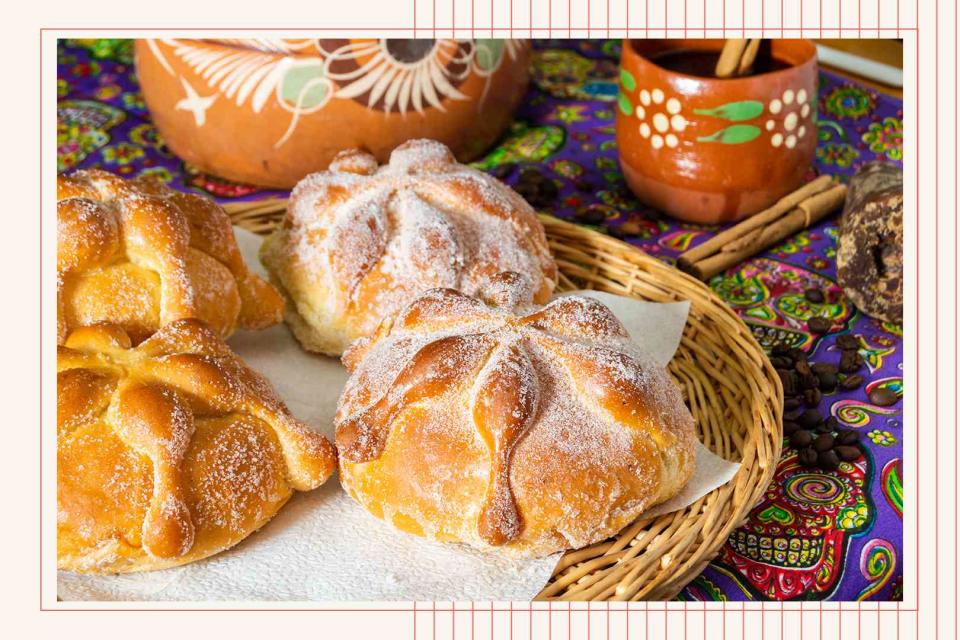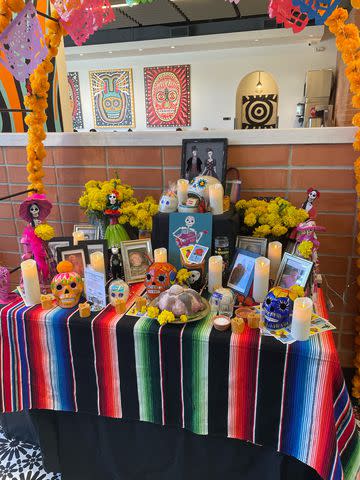How a James Beard Award–Winning Chef Uses Food to Celebrate Día de los Muertos
Learn how Houston-based restaurateur and chef Hugo Ortega blends slow cooking techniques and traditional Mexican street food influences in his celebration.

Robert Patrick Briggs / Getty Images
If you were to visit Mexico during the first few days of November, you’d find yourself surrounded by a vibrant celebration with flowing drinks, painted faces, and, most prominently, familial gatherings. Day of the Dead, or Día de los Muertos, has origins rooted in ancient Aztec times, and the holiday carries many long-standing traditions. One of the major aspects? Food.
“In the early ’70s, people all over the country migrated to Mexico City for a better opportunity,” says James Beard Award–winning chef Hugo Ortega, who opened his restaurant Urbe (meaning city) about eight years ago in Houston. “So when that happened, they brought their very best family recipes that they’ve made for generations. For example, from Puebla they brought how to make mole and tamales.”
At Urbe, Ortega wanted to represent the food that came out of this movement. He opened Urbe with the goal of serving flavor-packed Mexican street food. From tacos that Ortega describes as having “grease running down to your elbows” to tender carnitas, his dishes focus on the slow cooking technique tied to traditional Mexican cuisine—which means many of the recipes cook overnight.
:
He’s taking everything a step further for Día de los Muertos.
This year, Ortega has planned a special event to “commemorate the day as they would in Mexico,” he says, complete with tequila, music, and, of course, all the street food. Keep reading for advice on what to include on your own Day of the Dead menu, and discover the integral role food plays in celebrating this one-of-a-kind holiday.

Hugo Ortega
The Importance of Food on the Day of the Dead
When visiting a deceased loved one on Day of the Dead or decorating their ofrenda (altar), you can honor their life by preparing a dish they used to enjoy. At Urbe, Ortega sets up different food stations to represent flavors from the different regions of Mexico: quesadillas made with quesillo, an Oaxacan cheese; tamales made from fresh corn; house-made chocolate served with pan de muerto. Ortega describes his cooking with care and detail; his salsa de albañil gets its flavor profile from green tomatillos, cilantro, onions, and avocado, and his ceviche represents the abundant Gulf of Mexico.
:
“It’s something that’s close to my heart—it’s the food that identifies who I am,” Ortega says. “By [serving it], I represent my ancestors, and I represent the food that I’ve enjoyed throughout my life.”
The festivities also call for drinks: Traditional mezcal, rompope (or Mexican eggnog), and a punch made of tejocote (crab apple), cinnamon, pears, and sugar. It’s not uncommon for families to place some tequila on their ancestors’ ofrenda either—after all, the holiday is about celebrating.
How to Make Traditional Day of the Dead Food at Home
If you want to participate in the honoring of loved ones who have passed on or respectfully show your appreciation for Mexican culture, one of the easiest ways to do so is to cook the traditional dishes (or dine at your local Mexican restaurant). Ortega recommends picking up fresh masa from a Latin American grocery store to make tamales, as they’re a fairly simple entree.
“It’s cornmeal wrapped in a banana leaf or in a cornhusk, so you can’t go wrong with that,” he says. He also suggests serving a “small mole,” a recipe simpler than something like a mole negro. Include ingredients like chiles, onions, tomatoes, garlic, and chocolate, and spices like cloves and cinnamon.
For dessert, Ortega suggests trying out a capirotada, or a Mexican bread pudding. All you need is bread (whatever you have in your pantry will do, but use bolillo if you want to keep it traditional) soaked in a milk and eggs mixture and baked with raisins, cinnamon, and cheese. You can also buy chocolate and whisk it with a molinillo (a wooden Mexican whisk) until it's foamy.
“The most important thing is the spirit, and [to] create memories and remember those people,” Ortega says. “The Day of the Dead is the beginning of life, and the flavors are endless.”
false

